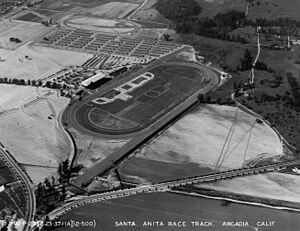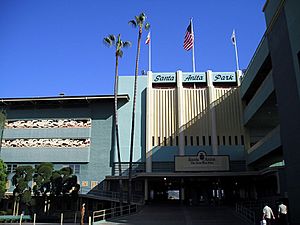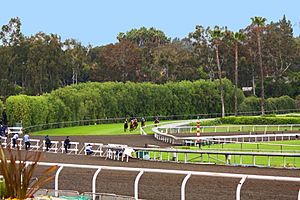Santa Anita Park facts for kids

Santa Anita Park logo
|
|
 |
|
| Location | 285 W. Huntington, Arcadia, California, U.S. |
|---|---|
| Coordinates | 34°08′26″N 118°02′40″W / 34.140635°N 118.044354°W |
| Owned by | Stronach Group |
| Date opened | December 25, 1934 |
| Course type | Thoroughbred flat racing |
| Notable races | Santa Anita Handicap (G1) Santa Anita Derby (G1) Sunshine Millions Day |
Santa Anita Park is a famous Thoroughbred racetrack located in Arcadia, California, United States. It's known for hosting some of the most important horse racing events in the U.S. during the fall, winter, and spring seasons. Many big races happen here, like the Santa Anita Derby and the Santa Anita Handicap.
Santa Anita Park has hosted the exciting year-end Breeders' Cup races eleven times, which is more than any other racetrack! In 1984, it was also the location for the horse riding events during the 1984 Summer Olympics. It was chosen again in April 2025 to host these events for the 2028 Summer Olympics. Since 2011, the Stronach Group has owned this historic park.
Contents
A Look Back in Time
The land where Santa Anita Park now stands was once part of a large ranch called "Rancho Santa Anita." It was first owned by Claudio Lopez and later by a Scotsman named Hugo Reid. The most famous owner of this land was a very rich businessman named Lucky Baldwin. He made a lot of money and became a successful breeder of racehorses. In 1904, Baldwin built a racetrack near the current location.
However, in 1909, California passed a law against gambling at racetracks. This law caused Baldwin's racetrack to close permanently. The racing facility then burned down in 1912.
In 1933, California made horse race betting legal again. This led to new groups wanting to open racetracks. Two groups, one led by Dr. Charles H. Strub and another by movie producer Hal Roach, joined forces. They formed the Los Angeles Turf Club and opened the current Santa Anita Park on Christmas Day in 1934. It was the first official racetrack in California.
The buildings at Santa Anita were designed by architect Gordon Kaufmann. They have a mix of old-fashioned Colonial Revival and a sleek Art Deco style. The buildings are painted in Santa Anita's special colors: Persian Green and Chiffon Yellow.
In February 1935, the first Santa Anita Handicap race was held. It had a huge prize of $100,000, which was the biggest prize for any race in the U.S. at that time! This earned it the nickname "the Big 'Cap."
Many famous movie stars, like Betty Grable, Lana Turner, and Clark Gable, used to visit the track. Even celebrities like Bing Crosby and Al Jolson owned parts of the park.
In 1940, the legendary horse Seabiscuit won the Santa Anita Handicap in his very last race.
A Special Place During World War II
In 1942, during World War II, horse racing at Santa Anita stopped. The park was used as a temporary home for Japanese Americans who were forced to leave their homes on the West Coast. For several months, over 18,000 people lived in horse stables and new barracks built on the site. This included actor George Takei, who was a young boy at the time.
After the war, the track reopened in 1945 and became popular again. In 1953, a special downhill grass course was added, giving the races a unique European feel.
Santa Anita and Hollywood
Because it's close to Los Angeles, Santa Anita has often been featured in movies and TV shows. Scenes from the classic movie A Day at the Races (1937) were filmed here. The movie The Story of Seabiscuit (1949) was also filmed on location. Many stars, including Bing Crosby and Spencer Tracy, owned horses that raced at the park.
In 1958, a record crowd of 61,123 people came to watch Silky Sullivan win the Santa Anita Derby.
Changes and Challenges
The 1960s brought big changes to Santa Anita Park, including a larger grandstand and more seating. In 1969, a new group called the Oak Tree Racing Association started holding autumn races at Santa Anita. This meet included many important races that prepared horses for the Breeders' Cup.
In 1984, Santa Anita hosted the horse riding events for the 1984 Summer Olympics. In 1985, the track set another attendance record with 85,527 people on Santa Anita Handicap Day.
In 1997, Santa Anita Park was bought by Meditrust, and later by Magna Entertainment Corp. In 2006, Santa Anita and Gulfstream Park worked together to host the Sunshine Millions, a day of races for horses bred in Florida and California.
In 2019, there were concerns about horse safety at the track. After several horses died, races were temporarily stopped so the dirt track could be studied. The California Racing Commission considered new rules to improve safety.
In March 2020, due to the COVID-19 pandemic, races continued without fans for a short time before being suspended until May 2020.
In January 2025, during the January 2025 Southern California wildfires, Santa Anita's parking lots were used to help people affected by the fires. Live racing was canceled for three days because of the fires and air quality.
The Race Tracks

Santa Anita has a main dirt track that is one mile (1,609 meters) long. Inside this, there's a grass (turf) course that is about 0.9 miles (1,584 meters) long. It also has a unique hillside turf course that crosses the dirt track. This special course is used for certain grass races.
In August 2020, Santa Anita started building a new turf chute for shorter grass races. This new chute was finished for the 2020/2021 winter season.
For a while, Santa Anita used a special synthetic (man-made) racing surface instead of dirt to follow a California rule. This new track opened in 2007. However, after some issues, Santa Anita brought back its natural dirt surface in December 2010.
The park covers 320 acres (1.3 square kilometers). Its grandstand, which is a historic landmark, is 1,100 feet (335 meters) long and can seat 26,000 guests. The grandstand's front still looks much like it did in the 1930s with its Art Deco style. The infield area is like a park with picnic tables and trees, and it can hold over 50,000 guests. Santa Anita also has 61 barns for more than 2,000 horses and a hospital for them.
Honoring Horse Racing Legends
At Santa Anita Park's European-style paddock, you can find statues of famous jockeys like George Woolf, Johnny Longden, Bill Shoemaker, and Laffit Pincay Jr.. There are also memorials for announcer Joe Hernandez and trainer Charlie Whittingham with his dog, Toby.
A life-size bronze statue of Seabiscuit stands in the walking ring. Another bronze statue of John Henry was added in 2009. In 2012, a life-size bronze statue of Zenyatta was unveiled.
Buried near the paddock are some of Lucky Baldwin's best horses, including Emperor of Norfolk, Volante, Silver Cloud, and Rey El Santa Anita.
Since 1950, Santa Anita Park has given out the George Woolf Memorial Jockey Award every year. This award goes to a jockey who shows great personal and professional behavior, both on and off the track.
Racing Events
Santa Anita Park hosts many important races throughout the year. These races are often grouped into different levels, called "Graded events," based on their importance.
The Breeders' Cup at Santa Anita
Santa Anita Park has hosted the Breeders' Cup a record 11 times, including in 2023. These events have seen many memorable moments:
- In 1986, Lady's Secret won the Distaff race and was named Horse of the Year.
- In 1993, Arcangues won the Classic race in one of the biggest upsets ever.
- In 2003, trainer Richard Mandella won a record four races, including the Classic.
- In 2009, Zenyatta made history by becoming the first mare (female horse) to win the Classic.
- In 2012 and 2013, Wise Dan won the Mile race two years in a row, earning him a Horse of the Year title.
- In 2016, Beholder won the Distaff in an exciting race against the undefeated Songbird.
- Also in 2016, Arrogate won the Classic in a thrilling finish over favorite California Chrome.
- In 2019, Storm the Court surprised everyone by winning the Juvenile at long odds.
Fun Events at the Park
Santa Anita Park is not just for horse racing; it's also a popular place for other events. Since 2013, it has hosted the 626 Night Market, a huge food festival. This event draws up to 100,000 people over a three-day weekend, four times a year during the summer. More than 250 vendors sell food, crafts, and art. There's also live music, an Art Walk, and dance competitions.
Arcadia High School holds its yearly graduation ceremony at Santa Anita Park in June. Alumni reunions also take place there in September and October.
See also
- Luck (TV series)
- Santa Anita Ordnance Training Center
- Arcadia County Park (formerly Santa Anita Recreational Park)






